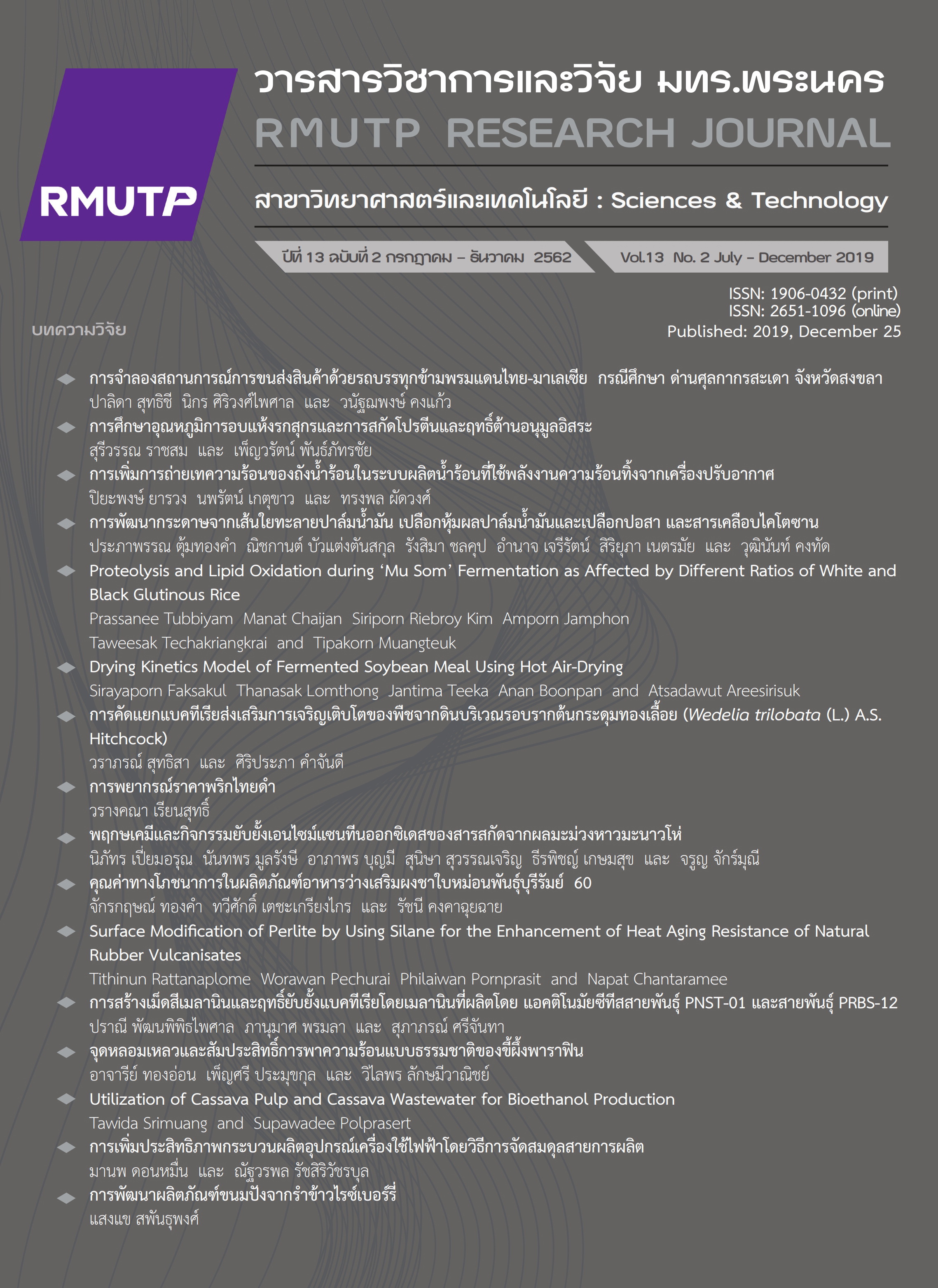Heat Transfer Enhancement of a Recovery Hot Water Tank from Waste Heat of Condensing Unit
Main Article Content
Abstract
This research is to study in heat transfer of hot water tank from an air conditioner which is a cylinder type and has a hot water pipe around the tank. It is used for finding a position and a pattern of distribution of the hot water pipe around the tank in the highest heat transfer condition. The study uses the cylinder of hot water tank filled 45 liters of 25 oC water. An experiment separates in 3 positions of pipe wrapping which are the bottom, the center and the top of the tank. Then, 80 oC of hot water run thought the hot water pipe which is wrapped around the tank for 120 minutes. The result of the experiment shows that tubing position that causes the highest heat transfer is at the bottom of tank. Pipe wrapping at the bottom of the tank has the heat transfer higher than the top of the tank at 30%. Furthermore, this experiment studies in spacing of hot water pipe. There are 3 types for testing which are spacing hot water pipe as one time, two times and three times of diameter of pipe. The result illustrates that spacing the hot water pipe can significantly increase the heat transfer. The heat transfer of spacing the hot water pipe in three times of diameter of pipe is higher 5.8 % than spacing in one times. In addition, this research is to study in the effect of turbulent flow on the heat transfer by installing agitator in order to stir water in the tank. The result is that water stirring in the tank for increasing the heat transfer is not effective for investment because the energy using for stirring is higher than the enhanced heat transfer.
Article Details
References
[2] T. Watesapan, N. Somsuk, T. Borirak and S. Teekasap, “Maximizing the Utilization of Air Conditioning Unit’s Energy,” EAU Heritage Journal, vol.6, no.1, pp. 49–55, Jan. 2012.
[3] H. Wongsuwan, “A Hot Water from Condensing Unit of a Split Type Air Conditioning and Controlled with Microcontroller,” in Proceeding of the 22nd Conference of Mechanical Engineering Network of Thailand, Oct 15-17, Thammasat University, Pathum Thani, Thailand, 2008, pp. 155-159.
[4] PAC Co.,Ltd. (2017, Oct 20). Wrap tank [Online]. Available: https://www. pac.co.th/product-overview/pac-frenergy/
[5] N. Katkhaw and S. Putivisutisak, “Mathematical Modeling for Radiation in Radiant Cooling Room,” in Proceeding of the 21st Conference of Mechanical Engineering Network of Thailand, Oct 17-19, Royal Thai Air Force Academy, Chonburi, Thailand, 2007, pp. 172-178.
[6] A. Muftuoglu and E. Belgin, “Natural convection in an open square cavity with discrete heaters at their optimized positions,” International Journal of Thermal Sciences, vol. 47, no.4, pp. 369–377, Apr. 2008.
[7] Q. H. Deng, “Fluid flow and heat transfer characteristics of natural convection in square cavities due to discrete source–sink pairs,” International Journal of Heat and Mass Transfer, vol. 51, no.25, pp. 5949–5957, Dec. 2008.
[8] P. Yaruang, N. Pongpanich and N. Katkhaw, “Simulation of Heat Transfer in Hot Water Tank with Outside Heat Source,” in Proceeding of the 14th Conference on Energy Network of Thailand, Jun 12-15, Rajamangala University of Technology Thanyaburi, Rayong, Thailand, 2018, pp. 41-46.


